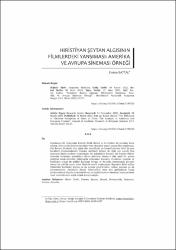| dc.description.abstract | Since the first years of cinema, countless movies have been made about different
religions and their themes that made favorable or unfavorable comments
and criticisms. In these films, one of the prominent representations has been
the character of Satan. In the history of cinema, the earliest film about the
representation of Satan is La Manoir du Diable, directed by French director
Georges Melies in 1896. From the first example to the present, many films about
Satan have been made and transferred to the silver screen.
The subject of this study is to determine how the films inspired by the Christian
tradition paint a portrait of Satan. Therefore the scope of this study is limited to
films that concretely depict Satan in European and American cinema which use
the Christian faith and culture intensively. In this study, it is aimed to determine
to what extent the producers or directors, who mention Satan or demonic forces,
benefit from the Christian scriptures or religious tradition and how they reflect the
issues that attract their attention to the screen.
In this study, in which qualitative research methods are used, on the one hand, an
existing situation has been tried to be described, on the other hand, it has been
aimed to examine the subject in depth. In this direction, the case study pattern
was used. In addition, the films that are the subject of the study were selected
in accordance with the homogeneous sampling, one of the purposive sampling
methods. In this context, 43 films from European and American cinema, which
use the devil motif, Christian belief and culture, have been watched and analyzed.
The data obtained from these movies have been analyzed by content analysis
technique. In this context, the following themes have been constituted: The
Naming of Satan, The Physical Appearence of Satan, Satan’s Desire to Have a
Son and Its Relationships with Antichrist, The Nature of Satan and Its Effect on
Human, Ways to Deal With the Devil and the Excorcism, The Exaltation of Satan
and Satanism.
In our country, studies on the use of the Devil motif in cinema films have been
emerged later than the West. In our country, when looking at the literature on
the use of religious elements in cinema films, it is seen that various studies have
been carried out in different disciplines, including the History of Religions. Among
these, there are also studies that mention the figure of Satan. Some of these studies
have touched on the percept of Satan in a limited way within the framework of
the motifs used in horror movies. In others, figure of Satan have evaluated only
in one or a few films. However in this study, a larger sample have included. The
data obtained within the scope of the sample have been diversified and classified
under different headings. In addition to these, it also offers the opportunity to
compare the data used between different films. In terms of these aspects, this
study differs from its similars in the literature. It is hoped that this study, which
aims to contribute to the enrichment of the literature in the field of the History
of Religions, will also open the door to new researches with contents such as
the representations of the devil or evil forces in other religions such as Judaism,
Hinduism, Shintoism apart from Christianity.
As a result, there is a serious diversity in the field of cinema about who Satan
is and what he represents. In this diversity Satan stands out as a character who
tries to seduce people and divert them from the right path, therefore needs to
be constantly fought. As it is known the idea of Satan in Christianity has shaped
the life of Western societies as well as individual perceptions of people. For many
years, a deep-rooted culture of fear has emerged Western societies which live
under the threat of Church, and grapple with the horror of Satan. This situation has naturally reflected in the cinema, and the idea that the Satan always follow
people has formed the basic material of horror films. Thus it can be said that
Satan has been generally reflected with his frightening aspect in the mentioned
films. However, it should be noted here that when these films are examined it is
noticed that Satan doesn’t have absolute frightening. Because although Satan is
presented as the winner of the struggle in some movies, it can often be seen that
he is defeated or even easily defeated. | en_US |


















